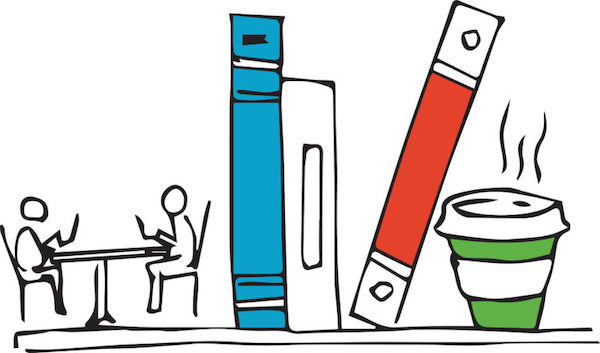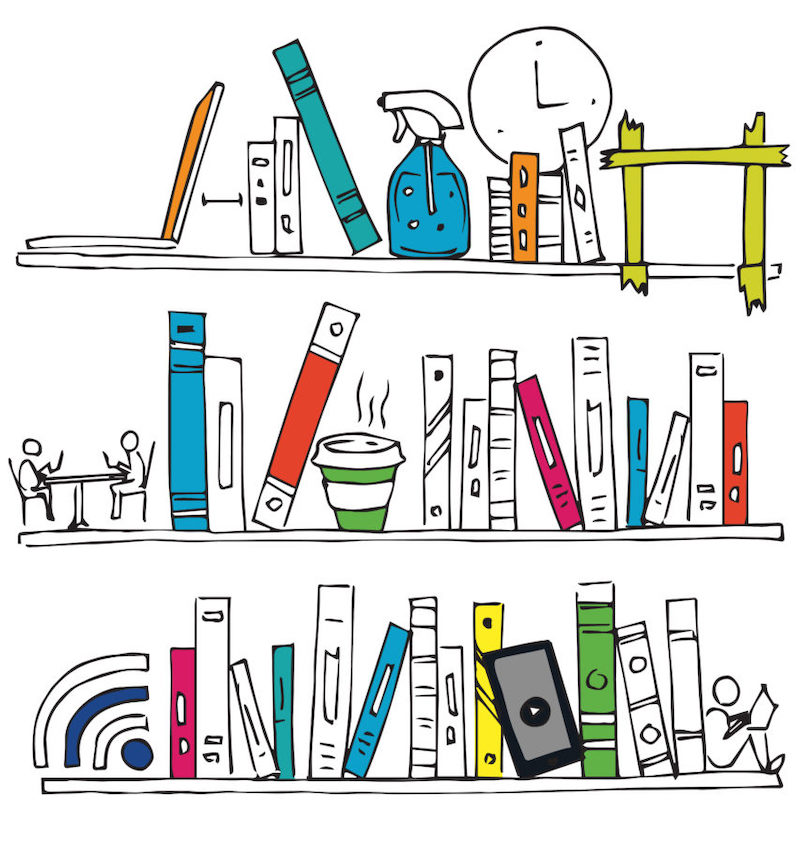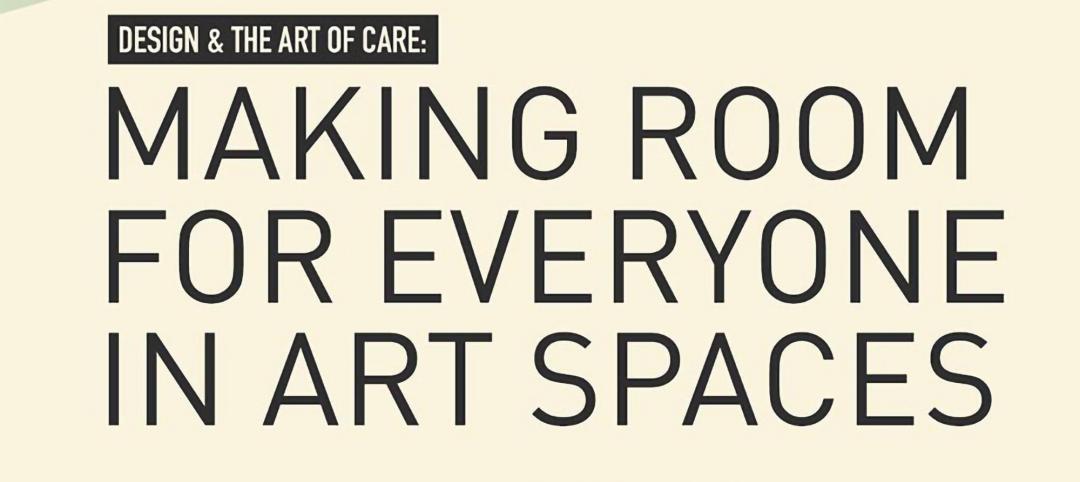The Coronavirus Pandemic forced 98% of all public libraries across the United States to close in April (American Library Association). While we miss our libraries, it’s been inspiring to see the creativity and dedication library workers have shown as they’ve taken steps to continue serving the public beyond the doors of the library.
In addition to expanding access to digital content in the form of eBooks, audiobooks, and streaming services, libraries across the country have curated reliable and timely information (on Covid-19, renters’ rights, tutorials on distance learning software, etc.). Libraries have also stepped up efforts to produce their own content with virtual story times and online knitting clubs. They’ve even ‘delivered’ stories by phone.
As architects, it has been especially interesting to see how public libraries have deployed their physical resources and spaces to continue serving their communities despite these closures. Some libraries, like our neighbor, the Public Library of Cincinnati & Hamilton County, are using their locations to distribute free meals to kids who no longer have access to lunch at school. Others have boosted the range of their WIFI or distributed hotspots to ensure that community members don’t fall through the digital safety net. Still others have converted to curbside service for physical lending to ensure safe, continued access to their resources.
But missing our libraries is about more than missing library services. We miss the sense of community that develops in a free, common space, where even if you don’t know their names you often develop a rapport—and sense of community—with people from all walks of life. So, as we miss our libraries, we’re asking ourselves how our experience with Covid-19 will reshape these spaces.
There’s a lot that we don’t know. As many states move to ease social distancing measures, we’re unsure of how large the growth in new cases will be. We don’t know whether Covid-19 could become a seasonal phenomenon in the coming years, forcing further closures in the fall (and beyond).
Still, it’s appropriate to ask what libraries can do in the short term and long term to adapt spaces and behaviors in order to ensure that our communities remain safe and resilient in the face of future pandemics.
Cleaning

Short Term: We’ve said it before, and we’ll say it again, we’re endorsing the advice of our favorite gyms. It’s important to wipe down equipment between uses. Providing disinfecting wipes (along with inspirational signage) can encourage patrons to help with the effort, but it will also be important that staff develop routines to ensure regular cleaning. Of course, it doesn’t stop there. According to the World Health Organization, corona virus may be able to survive on surfaces for days, if not properly cleaned. So, regularly wiping down desks, door handles, and other surfaces and scheduling more regular deep cleaning is advisable. It’s also worth making hand sanitizer available to your visitors.
Long Term: This experience should prompt libraries to appreciate the value of highly cleanable finishes – especially, for surfaces that the public regularly encounters (door handles, railings, desks, etc.). However, these finishes do not have to be “antimicrobial.” In fact, some antimicrobial products should be avoided due to environmental and health concerns.
Antimicrobial-treated furniture and fabrics contain added chemicals to suppress the growth of bacteria and viruses, but the Centers for Disease Control and Prevention (CDC) have found no evidence they work and many health systems are banning them for environmental and health reasons (Kaiser Permanente). Copper has received a lot of attention recently for its antimicrobial value, but its environmental impact should also be considered. Though it is naturally occurring and recyclable, it’s less likely to be recycled when it’s used as a surface treatment; and its extraction and disposal carry environmental risks.
In short, there is no better or more responsible defense than easily cleaned surfaces and a rigorous cleaning regimen.
Spacing & Traffic

Short Term: As the need to maintain social distancing persists (and it looks like it will for some time), consider artful strategies—strategies that communicate intention—to encourage people to respect each other’s space. American Libraries Magazine reports that prior to closing, some libraries experienced pushback against social distancing measures. A librarian from Windsor Public Library in Ontario, Canada for instance, described how visitors “actually lean(ed) in closer than they normally would” to bridge the distance that the staff tried to create by putting a cart in front of their circulation desk. Artful social distancing strategies, like these, which use brightly-colored tape to create beautiful, simple geometric designs may encourage people to respect social distancing measures by communicating their intentionality.
Of course, you should also consider removing chairs from conference rooms, shrinking occupancy limits, and hooding computers that are too closely spaced. To make up for decreased capacity indoors, libraries might consider whether they can add safely arranged outdoor spaces to enable more people to connect.
Medium to Long Range: Libraries might consider shifting their stock of computers to laptops that are distributed via a central kiosk. This would allow for more regular cleaning between uses while also facilitating social distancing by allowing users to disperse themselves throughout the library (instead of being forced into large banks of desktops).
Long Term: The key is flexibility. Eventually, we will ease social distancing, and we can all come within six feet of each other (thank goodness!). But good design can avoid pinch points, which would be helpful for future distancing measures; it can also use movable furniture and reconfigurable, flexible spaces to enable libraries to adapt to emergency situations – whether that involves food distribution or curbside service. The fact is, even if we don’t see another pandemic for a long time, we’ve consistently seen that in times of disaster, public libraries provide crucial community support. In recent years, libraries have offered shelter after hurricanes and wildfires, places to grieve after mass shootings, and emergency communication hubs during crises. So, whether designers are preparing for the next pandemic or the next natural disaster, it’s important to keep in mind the role of libraries as “second responders.”
Of course, flexible design strategies also enable libraries to adapt to more gradually changing community needs. As GBBN has pointed out before, the public library is not only an information center, it’s also a community center that is as vibrant as ever because it is free and public, and uniquely situated to offer flexible spaces and services that tend to the community’s needs.
Increased demand for third places

Short Term: As much of the country—both adults and children—find their home and work/school lives contained within the same four walls, many are experiencing a desire for what Ray Oldenburg (American urban sociologist) called a “third place” – the place where you relax in public, where you encounter familiar faces and make new social connections. As parents, we’ve noticed our children desiring more interaction (especially with their peers). In many ways, libraries are already bringing virtual third places into the homes of their users (with story times, group education opportunities, using Zoom to allow community groups to host public meetings, etc.). As libraries continue to seek out ways to meet these needs for children and adults, it is worth stressing the value of interactivity for overcoming the isolating effects of the present moment.
Long Term: Research from Gallup has shown that as a result of the corona virus 62% of US workers worked from home during the first half of April. Global Workplace Analytics, an analytics and research firm focused on workplace trends, predicts that as a result of increasing familiarity and comfort with remote working 25-30% of the workforce will continue to work from home multiple days a week by the end of 2021. That’s a LOT of people – and they won’t necessarily want to ‘work from home’… from home. As public spaces open back up, many will take their new-found ability to work from home to ‘third places,’ where they can experience social connection and belonging, even as they enjoy the quiet they need to get their work done.
Public libraries are in a great position to meet an increased demand for third places. They not only offer WIFI, printers, scanners, copiers, information resources, and a knowledgeable staff, but they also offer a variety of spaces to support different kinds of work (or for workers’ changing moods) throughout the day. When creating a variety of spaces throughout your library, it’s important to consider strategies for mitigating noise. Otherwise, the needs of different groups of library users (for example, the afterschool rush of kids and adults working out of the library) may come into conflict. By providing comfortable, welcoming spaces and forming partnerships to provide additional amenities—from good coffee to childcare options—libraries can offer a more compelling experience than the elbow-to-elbow seating at Starbucks, and welcome a new crop of workers through their doors.
We live in uncertain times, but the ongoing creativity and dedication of our public libraries is a bright spot in which we can glimpse a better future. As designers, it’s our task to provide spaces that enable the incredible flexibility they’ve shown in meeting their communities’ needs.
More from Author
GBBN | Sep 12, 2024
How space supports programming changes at university libraries
GBBN Associate Sarah Kusuma Rubritz, AIA, uses the University of Pittsburgh's Hillman Library to showcase how libraries are transforming to support students’ needs.
GBBN | Jul 3, 2024
New science, old buildings: Renovating for efficiency, flexibility, and connection
What does the research space of the future look like? And can it be housed in older buildings—or does it require new construction?
GBBN | Jun 3, 2024
Insights for working well in a hybrid world
GBBN Principal and Interior Designer Beth Latto, NCIDQ, LEED AP, ID+C, WELL AP, share a few takeaways, insights, and lessons learned from a recent Post Occupancy Evaluation of the firm's Cincinnati, Ohio, office.
GBBN | Feb 26, 2024
GBBN's Inflation Reduction Act Calculator goes live
GBBN has publicly released its IRA Calculator, a tool that helps you understand funding opportunities in the IRA for sustainable design.
GBBN | Jan 25, 2024
Tactical issues for renovating university research buildings
Matthew Plecity, AIA, ASLA, Principal, GBBN, highlights the connection between the built environment and laboratory research, and weighs the benefits of renovation vs. new construction.
GBBN | Dec 14, 2023
What's next for affordable housing in 2024?
As 2023 draws to a close, GBBN’s Mary Jo Minerich and Amanda Markovic, AIA sat down to talk about the future. What’s next in terms of trends, technology, and construction of affordable housing?
GBBN | Oct 11, 2023
Leveraging land and light to enhance patient care
GBBN interior designer Kristin Greeley shares insights from the firm's latest project: a cancer center in Santa Fe, N.M.
GBBN | Aug 31, 2023
Small town takes over big box
GBBN associate Claire Shafer, AIA, breaks down the firm's recreational adaptive reuse project for a small Indiana town.
GBBN | Jun 20, 2023
Designing arts spaces that curate inclusivity
GBBN's Julia Clements and Marcene Kinney, AIA, LEED AP, talk tips for designing inclusive arts spaces.
GBBN | Mar 22, 2023
Onsite prefabrication for healthcare construction: It's more than a process, it's a partnership
Prefabrication can help project teams navigate an uncertain market. GBBN's Mickey LeRoy, AIA, ACHA, LEED AP, explains the difference between onsite and offsite prefabrication methods for healthcare construction projects.
















